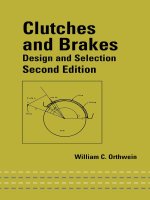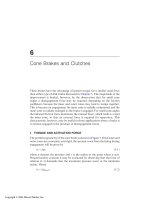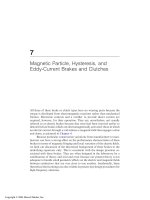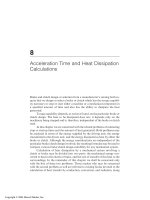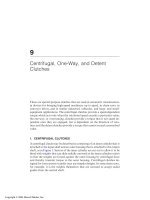58S01T0 hydraulic brakes operation and diagnosis 2004
Bạn đang xem bản rút gọn của tài liệu. Xem và tải ngay bản đầy đủ của tài liệu tại đây (1.13 MB, 122 trang )
MEDIUM DUTY TRUCK
HYDRAULIC BRAKES
OPERATION AND
DIAGNOSIS
1
3
2
4
3
Student Guide
FCS-13989-REFref
ORDER NUMBER:FCS-13989-REF
COURSE CODE:58S01T0
February, 2004
Ford Customer Service Division
Technical Training
IMPORTANT SAFETY NOTICE
Appropriate service methods and proper repair procedures are essential for the safe, reliable operation of all motor vehicles,
as well as the personal safety of the individual doing the work. This manual provides general directions for accomplishing
service and repair work with tested, effective techniques. Following them will help assure reliability.
There are numerous variations in procedures, techniques, tools and parts for servicing vehicles, as well as in the skill of the
individual doing the work. This manual cannot possibly anticipate all such variations and provide advice or cautions as to
each. Accordingly, anyone who departs from instructions provided in this manual must first establish that he compromises
neither his personal safety nor the vehicle integrity by his choice of methods, tools or parts.
As you read through the procedures, you will come across NOTES, CAUTIONS, and WARNINGS. Each one is there for a
specific purpose. NOTES give you added information that will help you to complete a particular procedure. CAUTIONS are
given to prevent you from making an error that could damage the vehicle. WARNINGS remind you to be especially careful
in those areas where carelessness can cause personal injury. The following list contains some general WARNINGS that you
should follow when you work on a vehicle.
•
•
Always wear safety glasses for eye protection.
•
•
•
To prevent serious burns, avoid contact with hot metal
parts such as the radiator, exhaust manifold, tail pipe,
catalytic converter and muffler.
Be sure that the ignition switch is always in the OFF
position, unless otherwise required by the procedure.
•
•
Do not smoke while working on the vehicle.
Set the parking brake when working on the vehicle. If you
have an automatic transmission, set it in PARK unless
instructed otherwise for a specific service operation. If
you have a manual transmission it should be in REVERSE (engine OFF) or NEUTRAL (engine ON) unless
instructed otherwise for a specific service operation.
•
Keep hands and other objects clear of the radiator fan
blades. Electric cooling fans can start to operate at any
time by an increase in underhood temperatures, even
though the ignition is in the OFF position. Therefore, care
should be taken to ensure that the electric cooling fan is
completely disconnected when working under the hood.
Use safety stands whenever a procedure requires you to
be under the vehicle.
•
Operate the engine only in a well-ventilated area to avoid
the danger of carbon monoxide.
•
Keep yourself and your clothing away from moving parts
when the engine is running, especially the fan and belts.
To avoid injury, always remove rings, watches, loose
hanging jewelry, and loose clothing before beginning to
work on a vehicle. Tie long hair securely behind your
head.
The recommendations and suggestions contained in this manual are made to assist the dealer in improving his dealership parts
and/or service department operations. These recommendations and suggestions do not supersede or override the provisions of
the Warranty and Policy Manual, and in any cases where there may be a conflict, the provisions of the Warranty and Policy Manual
shall govern.
The descriptions, testing procedures, and specifications in this handbook were in effect at the time the handbook was
approved for printing. Ford Motor Company reserves the right to discontinue models at any time, or change specifications,
design, or testing procedures without notice and without incurring obligation. Any reference to brand names in this manual
is intended merely as an example of the types of tools, lubricants, materials, etc. recommended for use. Equivalents, if
available, may be used. The right is reserved to make changes at any time without notice.
WARNING: Many brake linings contain asbestos fibers. When working on brake components, avoid breathing the dust. Breathing
the asbestos dust can cause asbestosis and cancer.
Breathing asbestos dust is harmful to your health.
Dust and dirt present on car wheel brake and clutch assemblies may contain asbestos fibers that are hazardous to your health when
made airborne by cleaning with compressed air or by dry brushing.
Wheel brake assemblies and clutch facings should be cleaned using a vacuum cleaner recommended for use with asbestos fibers.
Dust and dirt should be disposed of in a manner that prevents dust exposure, such as sealed bags. The bag must be labeled per
OSHA instructions and the trash hauler notified as to the contents of the bag.
If a vacuum bag suitable for asbestos is not available, cleaning should be done wet. If dust generation is still possible, technicians
should wear government approved toxic dust purifying respirators.
OSHA requires areas where asbestos dust generation is possible to be isolated and posted with warning signs. Only technicians
concerned with performing brake or clutch service should be present in the area.
Copyright © 2004 Ford Motor Company
Produced and Coordinated by
Technical Support Operations
Ford Customer Service Division
February, 2004
SERVICE STANDARDS
Mission Statement:
All dealership personnel will treat every customer as a potential lifetime
purchaser, communicating a professional image which embraces honesty
and concern for customer wants and needs.
Dealer-to-Customer Service Standards:
1. Appointment available within one day of
the customer’s requested service day.
2. Write-up begins within four minutes of
arrival.
3. Service needs courteously identified,
accurately recorded on Repair Order,
and verified with customer.
4. Vehicles serviced right on the
first visit.
5. Service status provided within one minute
of inquiry.
6. Vehicle ready at agreed upon time.
7. Thorough explanation of work done,
coverages and changes.
These seven service standards provide a process and product value that are compelling
reasons for owners to purchase and repurchase Ford or Lincoln-Mercury products. These
standards also help to attract new owners through favorable testimonials and improved owner
satisfaction.
Standard 4
“Fix It Right the First Time, on Time.”
The technician is the most important player when it comes to Standard #4.
Why
Customers tell us “Fixing It Right the First Time, on Time” is one of the reasons they would
decide to return to a dealer to buy a vehicle and get their vehicles serviced.
Technician Training
It is our goal to help the technician acquire all of the skills and knowledge necessary to
“Fix it Right the First Time, on Time.” We refer to this as “competency.”
Technician’s Role
Acquire the skills and knowledge for competency in your specialty via
STST
New Model
— Web-Based Training
— FORDSTAR
— Ford Multimedia Training (FMT)
— Instructor-Led
— Instructor-Led
The Benefits
The successful implementation of standards means
— Satisfied customers
— Repeat vehicle sales
— Repeat service sales
— Recognition that Ford and Lincoln/Mercury technicians are
“the Best in the Business”
Contents
INTRODUCTION AND PREREQUISITE REVIEW
FORD BRAKES SERVICE TECHNICIAN SPECIALITY TRAINING (STST) CURRICULUM ......................... Intro - 2
Curriculum Goals .......................................................................................................................................... Intro - 3
Air Brake System Operation and Diagnosis Instructor-Led Course Description ........................................... Intro - 3
Course Objective ........................................................................................................................................... Intro - 3
Lesson Objectives ......................................................................................................................................... Intro - 3
Audience ....................................................................................................................................................... Intro - 3
Course Prerequisites ..................................................................................................................................... Intro - 3
Evaluation ..................................................................................................................................................... Intro - 4
Student Guide ............................................................................................................................................... Intro - 4
Service Standards ......................................................................................................................................... Intro - 5
PREREQUISITE REVIEW ............................................................................................................................. Intro - 6
LESSON 1: HYDRAULIC BRAKES THEORY AND OPERATION
Introduction To Hydraulic Brake Systems ........................................................................................................... 1 - 2
Hydraulic Description ......................................................................................................................................... 1 - 3
Hydraulic Operation............................................................................................................................................ 1 - 4
Brake System Overview ..................................................................................................................................... 1 - 5
Master Cylinder .................................................................................................................................................. 1 - 6
Hydro-Max Description ....................................................................................................................................... 1 - 8
Hydro-Max Operation ......................................................................................................................................... 1 - 9
ABS Description ............................................................................................................................................... 1 - 16
ABS Operation ................................................................................................................................................. 1 - 17
Parking Brake System ...................................................................................................................................... 1 - 18
Auxiliary Brake System Description and Operation .......................................................................................... 1 - 19
LESSON 2: COMPONENTS
Hydraulic Brake System Components ................................................................................................................ 2 - 2
Disc Brake System Components ........................................................................................................................ 2 - 3
Hydro-Max System Components ..................................................................................................................... 2 - 13
ABS System Components ................................................................................................................................ 2 - 19
Parking Brake System Components ................................................................................................................. 2 - 26
LESSON 3: DIAGNOSIS
Diagnosis and Testing ........................................................................................................................................ 3 - 2
Preliminary Brake System Checks ..................................................................................................................... 3 - 3
Diagnostic Test ................................................................................................................................................... 3 - 4
Common Customer Concerns .......................................................................................................................... 3 - 12
Brake Pedal Conditions .................................................................................................................................... 3 - 15
Hydro-Max Booster Diagnostics ....................................................................................................................... 3 - 24
ABS Diagnostics .............................................................................................................................................. 3 - 28
Meritor-WABCO Toolbox Software Functions ................................................................................................... 3 - 29
Standard ABS Testing ...................................................................................................................................... 3 - 31
Standard ABS Component Testing ................................................................................................................... 3 - 31
i
APPENDIX ............................................................................................................. Appendix - 1
GLOSSARY ............................................................................................................ Glossary - 1
TOOL LIST ...................................................................................................................... Tool - 1
ROTUNDA ORDER FORM ...................................................................................... Rotunda - 1
ii
INTRODUCTION AND PREREQUISITE REVIEW
INTRODUCTION AND PREREQUISITE REVIEW
OBJECTIVES
CONTENTS
Review the Ford Medium Duty Truck Brakes
Service Technician Speciality Training (STST)
Curriculum
Introduction to the Ford Medium Duty Truck
Brakes Service Technician Speciality Training
(STST) Curriculum
Administer the prerequisite review
Prerequisite Review
Hydraulic Brakes Operation and Diagnosis
February, 2004
Intro - 1
INTRODUCTION AND PREREQUISITE REVIEW
FORD MEDIUM DUTY (MD) TRUCK BRAKES SERVICE TECHNICIAN SPECIALITY
TRAINING (STST) CURRICULUM
MD TRUCK BRAKES CURRICULUM MAP
Electrical/Electronic Curriculum
MD Truck Hydraulic Brakes Theory and Operation
Web Based Training - Course Code 58S03W0
MD Truck Air Brakes Theory and Operation Web Based
Training - Course Code 58S01W0
MD Truck Air Brakes Service and Diagnosis Web Based
Training - Course Code 58S02W0
MD Truck Hydraulic Brakes Operation and Diagnosis Instructor-Led
Training - Course Code 58S01T0
MD Truck Air Brakes Service and Diagnosis Instructor-Led Training Course Code 58S02T0
Courses of The Ford Medium Duty Truck Brakes Service Technician Speciality Training (STST)
Curriculum
The Ford Medium Duty Truck Brakes Service Technician Speciality Training (STST) Curriculum consists of five
courses related to brake system operation and diagnosis. Each course in the curriculum is a “building block” for
the next course in the curriculum.
This curriculum is designed for technicians who want to learn the methods and techniques to properly diagnose
and service brake systems and components.
Intro - 2
February, 2004
Hydraulic Brakes Operation and Diagnosis
INTRODUCTION AND PREREQUISITE REVIEW
Curriculum Goals
The goals of this curriculum are to provide:
The necessary training to enable the technician to identify, diagnose and perform timely “Fix It Right The
First Time On Time” repairs
Increased customer satisfaction.
Increased technician productivity.
Fewer repeat repairs.
Medium Duty Truck Hydraulic Brakes Operation and Diagnosis Instructor-Led Course
Description
This is the first instructor-led course in the Medium Duty Truck Brakes Curriculum. It is a two-day course facilitated by an instructor. This course is designed to provide hands-on opportunities for technicians to learn and
improve their skills using tools and equipment; and to apply knowledge learned in previous curriculum courses.
Course Objective
Given the information presented in the Ford Medium Duty Hydraulic Brake System Operation and Diagnosis
Course, the necessary service information and tools, technicians will be able to perform accurate, timely, costeffective diagnosis and repair of ABS, Hydro-Max, and basic hydraulic brake systems on Ford Motor Company
Medium Duty Trucks.
Lesson Objectives
Each lesson of this course starts with a list of objectives for the participants. The lesson objectives are designed to
support the course objective.
Audience
This course is designed for any Ford and Lincoln and Mercury service technicians who are enrolled in the Ford
Medium Duty Truck Brakes Service Technician Speciality Training (STST) Curriculum. Additionally, this course
is also designed for training service technicians of Ford Designated Fleets.
Course Prerequisites
All students must have completed the first course in the curriculum prior to enrolling in this course. If you have
not completed all of the prerequisite courses please notify your instructor.
Automotive Electrical 34S14T0
Automotive Electronics 34S19T0
Medium Duty Truck Hydraulic Brakes Theory and Operation Web Based Training - Course Code 58S03W0
Hydraulic Brakes Operation and Diagnosis
February, 2004
Intro - 3
INTRODUCTION AND PREREQUISITE REVIEW
Evaluation
Each technician attending this course will be required to pass a combination hands-on/written evaluation. This will
be administered on the afternoon of the second day. The hands-on evaluation is a pass/fail type.
Hands-on evaluations will be conducted with exercises in:
–
ABS diagnosis
–
Written evaluation
–
Special tool usage
In order to pass the course, you must demonstrate acceptable skills at the evaluated hands-on exercises and you
must answer at least 80% of the written post test questions correctly.
Student Guide
The Student Guide contains the worksheets used at the workstations for each of the two days. You must complete
each worksheet.
IMPORTANT: Actively participate in exercise reviews. This is your opportunity to ask questions and clear up any
areas that you may not fully understand.
Intro - 4
February, 2004
Hydraulic Brakes Operation and Diagnosis
INTRODUCTION AND PREREQUISITE REVIEW
SERVICE STANDARDS
Mission Statement
All dealership personnel will treat every customer as a potential lifetime purchaser, communicating a professional
image that embraces honesty and concern for customer wants and needs.
Dealer-to-Customer Service Standards
Appointment available within one day of the customer’s requested service day.
Write-up begins within four minutes of arrival.
Service needs courteously identified, accurately recorded on Repair Order, and verified with customer.
Standard 4
Vehicles Serviced Right on the First Visit:
Service status provided within one minute of inquiry.
Vehicle ready at agreed upon time.
Thorough explanation of work done, coverages and charges.
The technician is the most important player when it comes to Standard 4.
“Fix it Right the First Time, on Time”
Why:
Customers tell us “Fixing It Right the First Time, On Time” is one of the top reasons they would decide to return
to a dealer to buy a vehicle and get their vehicles serviced.
Technician Training
It is our goal to help the technician acquire all of the skills and knowledge necessary to “Fix It Right the First
Time, On Time.” We refer to this as “competency.”
Technician’s Role
The technician’s role is to acquire the skills and knowledge for competency in your specialty via:
FMT (self-study)
FORDSTAR Network (new model and curriculum)
New Model (self-study and instructor-led)
STST (instructor-led)
Web-Based Training (self-study)
Benefits
The successful implementation of standards means:
Satisfied customers
Repeat vehicle sales
Increased service department utilization
Recognition that Ford and Lincoln/Mercury technicians are “the Best in the Business”
Hydraulic Brakes Operation and Diagnosis
February, 2004
Intro - 5
INTRODUCTION AND PREREQUISITE REVIEW
PREREQUISITE REVIEW
INTRODUCTION
This course begins with a review of the content covered in the prerequisite web-based courses. The review is
designed to help you recall the key points and basic concepts of these courses. Comprehension of these key points
and concepts is essential to being successful in this course.
Directions: Select the best answer for the questions listed on the following pages.
1. Friction is:
A. Applied fluid pressure
B. Resistance of movement between two surfaces in contact
C. The amount of movement of a hydraulic component
D. Energy of motion
2. Heat energy is:
A. Created by friction
B. Able to be compressed
C. Used to multiply force
D. None of the above
3. Friction occurs between:
A. Kinetic energy and motion.
B. The brake backing plate and the axle.
C. The brake pad and the spinning rotor.
D. All of the above
4. Which of the following statements are true about levers?
A. Levers are used to multiply force.
B. Levers are used to overcome resistance.
C. Levers are supported at a point called a fulcrum.
D. All of the above
5. Which of the following are hydraulic principles?
A. Liquid in a confined space will not compress.
B. When pressure is applied to liquid in a confined space, the pressure will be transferred equally in all
directions.
C. A hydraulic system can be used to increase or decrease force or motion.
D. All of the above
Intro - 6
February, 2004
Hydraulic Brakes Operation and Diagnosis
INTRODUCTION AND PREREQUISITE REVIEW
6. Ford medium duty trucks utilize a hydraulic booster called?
A. Hydro-Boost
B. Hydro-Max
C. Hydro-Pressure.
D. Fluid-Filled.
7. The primary purpose of the _________________ is to develop and maintain hydraulic pressure in the system.
A. Brake caliper
B. Brake line
C. Spindle
D. Master cylinder
8. The elastic action of the _________________ pulls the caliper piston back into its bore when the brakes are
released.
A. Brake lever assembly
B. Piston seal
C. Reservoir diaphragm gasket
D. None of the above
9. The ________________ receives signals from the wheel speed sensors and processes the information to
determine if ABS operation is necessary.
A. Brake on/off switch
B. Hydraulic Control Unit
C. ABS control module
D. ABS indicator lamp.
10. It is necessary to purge the air from the master cylinder whenever it is replaced. This action is called:
A. Bench bleed
B. Gravity bleed
C. Full bleed
D. Manual bleed
Hydraulic Brakes Operation and Diagnosis
February, 2004
Intro - 7
INTRODUCTION AND PREREQUISITE REVIEW
NOTES
Intro - 8
February, 2004
Hydraulic Brakes Operation and Diagnosis
LESSON 1: HYDRAULIC BRAKES THEORY AND OPERATION
LESSON 1: HYDRAULIC BRAKES THEORY AND OPERATION
OBJECTIVES
Upon completion of this lesson the student will
be able to:
–
CONTENTS
Introduction to hydraulic brake systems
Hydraulic description and operation
Explain the basic principles of the hydraulic
brake system.
Hydraulic brake system overview
–
Describe the basic operation of a hydraulic
brake system.
Master cylinder description and operation
–
Identify the basic operation of the HydroMax system operation.
Hydro-Max description and operation
ABS description and operation
–
Identify the basic operation of an anti-lock
hydraulic brake system.
Parking brake description and operation
–
Explain the basic operation of the parking
brake system.
Auxiliary brake system description and operation
–
Identify the basic operation of the auxiliary
brake system.
Hydraulic Brakes Operation and Diagnosis
February, 2004
1-1
LESSON 1: HYDRAULIC BRAKES THEORY AND OPERATION
INTRODUCTION TO HYDRAULIC BRAKE SYSTEMS
MDH-001
Hydraulic Brake System
As you have learned while taking the web-based training in this curriculum, the purpose of the MD truck hydraulic brake system is to provide a safe method of stopping for a heavier vehicle.
The components of a medium duty truck hydraulic brake system are:
–
Brake pedal assembly
–
Brake booster
–
Master cylinder
–
Brake lines
–
Wheel brake assemblies
This lesson will review the operation of these subsystems in order to help you perform diagnosis and service.
The components of a hydraulic brake system can differ, however, all systems operate in a similar manner.
The hydraulic brake system must provide balanced braking at all wheels.
–
This will provide maximum brake system performance.
–
Brake system balance can be affected by worn, damaged or faulty components.
NOTE: For a more detailed explanation of the theory and operation of a hydraulic system refer to the web-based
training course.
1-2
February, 2004
Hydraulic Brakes Operation and Diagnosis
LESSON 1: HYDRAULIC BRAKES THEORY AND OPERATION
HYDRAULIC DESCRIPTION
2
1
3
4
MDH-002
Hydraulic Description
Item
Description
Item
Description
1
12 lbs. (4.5 kg) of Force
3
Liquid
2
48 lbs. (18 kg) Lift
4
Connecting Tube
A hydraulic system is basically a system that uses a liquid to transmit motion or pressure from one point to
another. Hydraulic brake systems use a confined brake fluid to transfer brake pedal motion and pressure to
each of the wheel brake assemblies.
Hydraulic theory operates on a few important principles. These principles include:
–
Liquid in a confined space will not compress.
–
When pressure is applied to liquid in a confined space, the pressure will be transferred equally in all
directions.
–
A hydraulic system can be used to increase or decrease force or motion.
Hydraulic Brakes Operation and Diagnosis
February, 2004
1-3
LESSON 1: HYDRAULIC BRAKES THEORY AND OPERATION
HYDRAULIC OPERATION
MDH-003
Hydraulic Operation with Equal Size Pistons
Item
1
Description
Piston Sroke 5 cm (2 inch)
Item
2
Description
Pressure Applied 15 kPa (2 psi)
Suppose two cylinders of equal diameter are placed side by side with a tube connecting them. The system is
filled with liquid. Each cylinder contains a piston. If you push down on one of the pistons, the other piston
will move an equal distance and with equal force.
Since the liquid will not compress and the cylinders are the same diameter, the same amount of liquid, and
motion is transferred from one cylinder to the other.
When pistons of different sizes are used, motion and force can be increased or decreased. Suppose a small
piston acts on a large piston. The larger piston will move with more force. However, it will move a shorter
distance.
When a large diameter piston acts on a smaller piston, the opposite is true. The smaller piston slides farther in
its cylinder than the large piston, but it moves with less force.
1-4
February, 2004
Hydraulic Brakes Operation and Diagnosis
LESSON 1: HYDRAULIC BRAKES THEORY AND OPERATION
BRAKE SYSTEM OVERVIEW
8
1
3
2
7
4
6
5
MDH-004
Hydraulic Brake System
Item
Description
Item
Description
1
Master Cylinder
5
Wheel Speed Sensor
2
Hydro-Max Booster
6
Power Steering Gear
3
4
Rear Disc Rotor
7
Power Steering Pump
ABS Control Module
8
Front Disc Rotor
Description and Operation
The standard hydraulic brake system featured on the Ford medium duty trucks consist of the following:
–
Hydro-Max booster
–
Split mini master cylinder
–
Front disc brakes
–
Rear disc brakes
–
Power steering pump with remote reservoir
–
Driveline mounted parking brake
Ford MD trucks use a front/rear split hydraulic brake system. The primary brake system controls the front
disc brakes and the secondary system controls the rear disc brakes.
It is very important to note that the hydraulic brake system uses two total separate fluids. The power steering
pump, which provides brake boost uses automatic transmission fluid. The master cylinder uses DOT 3 brake
fluid.
Hydraulic Brakes Operation and Diagnosis
February, 2004
1-5
LESSON 1: HYDRAULIC BRAKES THEORY AND OPERATION
MINI MASTER CYLINDER
1
6
3
2
5
4
MDH-005
Mini Master Cylinder Operation
Item
Description
Item
Description
1
Low Pressure
4
Electric Motor (not operating)
2
3
High Pressure
5
Primary Piston
Brake Pedal Push Rod
6
Secondary Piston
Operation
The mini-master cylinder actuating system for each set of brakes is mechanically separated into two independent hydraulic systems. Hydraulic failure in one system does not affect function of the other system.
Each pressure chamber has a piston/actuator sub-assembly containing a preload (caged) spring and a return
spring. In the released position, actuators of both the primary and secondary pistons are in contact with their
respective compensating valve stems, which project into the cylinder bore. This maintains the valve in an open
position, which allows hydraulic fluid in the reservoir to replenish any fluid displaced from the cylinder bore.
Initial forward travel of the primary pistons moves the primary actuator away from its compensating valve
counterpart, permitting the valve to seat. Closure of this valve shuts off the passage between the primary
pressure chamber and the reservoir section serving the primary chamber.
1-6
February, 2004
Hydraulic Brakes Operation and Diagnosis
LESSON 1: HYDRAULIC BRAKES THEORY AND OPERATION
MINI MASTER CYLINDER (continued)
Further movement of the primary piston creates a pressure in the primary pressure chamber causing the
secondary piston and actuator to move. As the secondary piston and actuator move, the secondary compensating valve closes, shutting off the passage between the secondary pressure chamber and the reservoir section
serving the secondary chamber. Additional movement of the primary piston causes both chambers to build
pressure.
When the load on primary piston is removed, fluid pressure in each chamber, combined with return spring
force, causes the primary and secondary piston to return to their initial released position. Each actuator opens
its respective compensating valve, reopening the passage between the individual reservoir sections and its
associated pressure chamber.
Should the rate of release be great enough to cause a partial vacuum in a chamber, the compensating valve will
open to allow replenishment of fluid in the cylinder bore.
Any excess fluid remaining at the end of the stroke due to “pumping” and/or volume change due to temperature fluctuation is released as the compensating valve ports open.
Hydraulic Brakes Operation and Diagnosis
February, 2004
1-7
LESSON 1: HYDRAULIC BRAKES THEORY AND OPERATION
HYDRO-MAX DESCRIPTION
1
2
MDH-006
Hydro-Max Booster and Master Cylinder
Item
1
Description
Hydro-Max Booster
Item
2
Description
Mater Cylinder
The hydro-max brake system has an electrically powered reserve hydraulic pump that operates if there is a
malfunction of the hydraulic pump system or when the engine is OFF. It also has a mechanical push through
capability if both of the other systems malfunction. The push through provides a greatly reduced braking power,
and the vehicle should not be operated in this mode except for emergency removal of the vehicle from the road.
The system uses two totally separate fluids for operation.
–
Power steering fluid (ATF) in the pump, steering gear and power brake booster unit. The system fill is
accomplished at the power steering pump reservoir and air is automatically removed from the system
while the pump is operating.
–
Hydraulic brake fluid is used in only the master cylinder. Adding fluid and bleeding air from the system
are accomplished in the same manner as with manual or vacuum boosted brakes.
The Hydro-Max booster works with a mini-master cylinder to supply the stopping power to the split hydraulic brake system.
The mini-master cylinder actuating system for each set of brakes is mechanically separated into two independent hydraulic systems. Hydraulic failure in one system does not affect function of the other system.
1-8
February, 2004
Hydraulic Brakes Operation and Diagnosis
LESSON 1: HYDRAULIC BRAKES THEORY AND OPERATION
HYDRO-MAX OPERATION
1
8
2
3
7
4
5
6
MDH-007
Hydro-Max Operation
Item
Description
Item
Description
1
2
Integral Flow Switch (closed)
5
Output Push Rod
Inlet Pressure Port
6
Primary Piston
3
Input Pedal Rod
Secondary Return Spring
4
Power Piston
7
8
Integral Flow Switch (open)
The primary function of the booster is to receive hydraulic fluid pressure through the inlet pressure port and
use this pressure against the power piston to drive the output push rod against the primary piston and actuator
sub-assembly in the mini-master cylinder.
Under normal conditions, depressing the brake pedal will force the input pedal rod against the valve rod and
the reaction piston. The reaction piston moves forward to close the pressure poppet (pressure valve). Closing
the pressure valve reduces the fluid flow into the area in front of the power piston (low pressure chamber).
This action increases the forward pressure acting on the large diameter power piston, which in turn forces the
output push rod into the master cylinder. This action causes the Mini-Master cylinder to operate as previously
described.
The area between the hydro-max push rod forward o-ring and the primary piston rear o-ring of the master
cylinder is vented to the atmosphere. This venting prevents mixture of the brake fluid with the power steering
fluid in the event one or both of these o-rings begin leaking.
Hydraulic Brakes Operation and Diagnosis
February, 2004
1-9
LESSON 1: HYDRAULIC BRAKES THEORY AND OPERATION
Hydro-Max Operation (continued)
8
1
7
2
3
4
6
5
MDH-008
Engine Running - No Brake Application
Item
Description
Item
Description
1
Flow Switch
5
Low Pressure Chamber
2
Inlet Check Valve
Master Cylinder Push Rod (at rest)
3
4
Pressure Valve (open)
6
7
Brake Pedal Push Rod (at rest)
8
Fluid Return
Flow Switch (open)
Engine Running - No Brake Application
When the total system is functioning properly and the hydraulic pump is supplying the Hydro-Max unit, the
flow through the unit includes the following:
–
Flow pressure from the power steering pump holds the hydro-max booster inlet check valve open.
–
Before the brake pedal is applied, fluid passes freely through the pressure valve and into the low pressure
chamber.
–
Fluid passing out of the unit holds the flow switch open, preventing operation of the electric motor pump.
–
No pressure is applied to the power piston and the master cylinder push rod is at rest.
–
No action takes place in the master cylinder and no brake application is experienced.
1 - 10
February, 2004
Hydraulic Brakes Operation and Diagnosis
LESSON 1: HYDRAULIC BRAKES THEORY AND OPERATION
Hydro-Max Operation (continued)
7
1
2
6
3
5
4
MDH-009
Engine Running - Light Brake Application
Item
Description
1
Inlet Check Valve
2
3
4
Item
Description
Master Cylinder Push Rod Begins To Move
Brake Pedal Push Rod (partly applied)
5
6
Reaction Piston
7
Flow Switch (open)
Primary Piston (moves)
High Pressure Chamber
Engine Running - Light Brake Application
When the brake pedal has been depressed slightly, the power assist action of the Hydro-Max unit begins. The
flow through the unit includes the following:
–
Flow pressure from the power steering pump holds the hydro-max booster inlet check valve open.
–
The brake pedal push rod begins to close the pressure valve. As the flow is restricted, pressure builds-up in
the high pressure chamber. The power piston is pushed by the build-up of pressure and results in power
boosted movement to the master cylinder through the master cylinder push rod.
–
Fluid passing out of the unit holds the flow switch open, preventing operation of the electric motor pump.
–
The forward movement of the master cylinder push rod forces the primary piston and actuator away from
its compensating valve.
–
Hydraulic pressure builds in the primary braking system and both the primary (front) and secondary (rear)
brakes are applied.
Hydraulic Brakes Operation and Diagnosis
February, 2004
1 - 11
